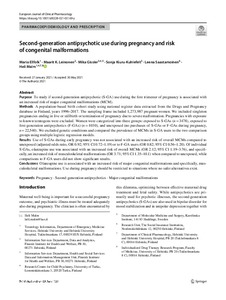Second-generation antipsychotic use during pregnancy and risk of congenital malformations
Ellfolk Maria; Leinonen Maarit K.; Gissler Mika; Kiuru-Kuhlefelt Sonja; Saastamoinen Leena; Malm Heli
https://urn.fi/URN:NBN:fi-fe2021093048260
Tiivistelmä
Purpose To study if second-generation antipsychotic (S-GA) use during the first trimester of pregnancy is associated with an increased risk of major congenital malformations (MCM).
Methods A population-based birth cohort study using national register data extracted from the Drugs and Pregnancy database in Finland, years 1996-2017. The sampling frame included 1,273,987 pregnant women. We included singleton pregnancies ending in live or stillbirth or termination of pregnancy due to severe malformation. Pregnancies with exposure to known teratogens were excluded. Women were categorized into three groups: exposed to S-GAs (n = 3478), exposed to first-generation antipsychotics (F-GAs) (n = 1030), and unexposed (no purchases of S-GAs or F-GAs during pregnancy, n = 22,540). We excluded genetic conditions and compared the prevalence of MCMs in S-GA users to the two comparison groups using multiple logistic regression models.
Results Use of S-GAs during early pregnancy was not associated with an increased risk of overall MCMs compared to unexposed (adjusted odds ratio, OR 0.92; 95% CI 0.72-1.19) or to F-GA users (OR 0.82; 95% CI 0.56-1.20). Of individual S-GAs, olanzapine use was associated with an increased risk of overall MCMs (OR 2.12; 95% CI 1.19-3.76), and specifically, an increased risk of musculoskeletal malformations (OR 3.71; 95% CI 1.35-10.1) when compared to unexposed, while comparisons to F-GA users did not show significant results.
Conclusions Olanzapine use is associated with an increased risk of major congenital malformations and specifically, musculoskeletal malformations. Use during pregnancy should be restricted to situations where no safer alternatives exist.
Kokoelmat
- Rinnakkaistallenteet [27094]
